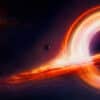
Icy exoplanet discovered with liquid ocean (and possibly atmosphere) in habitable zone
⇧ [VIDÉO] You may also like this partner content
The James Webb Space Telescope has been making discoveries since its launch in 2021. Last May, it broke a distance record by discovering a very distant galaxy. It has also revealed hundreds of roaming planets inside the Orion Nebula. And most recently, it achieved a new milestone by allowing a team of planetary scientists from the National Center for Scientific Research — in collaboration with astronomers from the University of Montreal — to identify an icy exoplanet that could have an atmosphere similar to Earth’s.
” This is the first time we've observed a hint of an atmosphere on a rocky or ice-rich exoplanet in the habitable zone. “, announced in statement Ryan MacDonald, a researcher at the University of Michigan and NASA. The exoplanet, called LHS 1140 b, was discovered in 2017. It is located about 48 light-years from Earth, in the constellation Cetus, and orbits a low-mass red dwarf star about one-fifth the size of the Sun and 1.7 times the size of Earth. Since its discovery, it has been closely monitored by the Hubble, Spitzer, and TESS space telescopes.
Teams from the National Center for Scientific Research and the University of Montreal had already collaborated on these observations, which later allowed them to accurately measure the mass and diameter of LHS 1140 b. They thus discovered that the planet has a low density, indicating the presence of a thick envelope of hydrogen and helium. This is why scientists initially thought it was a mini-Neptune.
However, in December 2023, the James Webb Space Telescope, using its Near-Infrared Imaging and Slit Spectrometer (NIRISS) instrument, revealed that the exoplanet LHS 1140 had in fact lost its hydrogen and helium atmosphere. Thus, by analyzing the latest data sent back by the James Webb Space Telescope, the researchers ruled out the mini-Neptune scenario. The evidence the team gathered suggests that the exoplanet is a rocky or icy “super-Earth.” It would also be rich in water, making it an ideal candidate for searching for extraterrestrial life.
McDonald and his team's observations also suggest that the planet may orbit in the habitable zone around its star. This suggests that LHS 1140 b is receiving enough radiation to allow liquid water to exist.”
LHS 1140 b is one of the best small exoplanets in the habitable zone, capable of harboring a thick atmosphere that we know of, and we may have just found traces of air on this world. “McDonald added,”
Possible presence of nitrogen and ocean
” Of all the temperate exoplanets currently known, LHS 1140 b may be our best chance of one day indirectly confirming the presence of liquid water on the surface of an alien world outside our solar system. “In fact, by conducting an independent and simultaneous analysis using another instrument on the James Webb Space Telescope, NIRSpec (an instrument that operates at different wavelengths than NIRISS), the scientists discovered that the planet’s low density is due to the presence of a much larger amount of water than NIRISS on Earth. They then estimate that between 10 and 20% of its mass is made up of water. This discovery also suggests that LHS 1140 b is like a “snowball” or icy planet, with an ocean of liquid water.
See also

A more in-depth analysis suggests that the exoplanet's atmosphere is very rich in nitrogen. Thus, according to the team, the ocean surface could be about 4,000 kilometers in diameter, with a surface temperature in the middle of the ocean of about 20 degrees Celsius.” Although we need more observations from the James Webb Space Telescope to confirm the nitrogen-rich atmosphere and search for other gases, this is a very promising start. “It’s a very good idea,” McDonald concludes.
source : Astrophysical Journal Letters

“Incurable web evangelist. Hipster-friendly gamer. Award-winning entrepreneur. Falls down a lot.”
